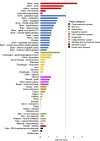Cluster Headache Genomewide Association Study and Meta-Analysis Identifies Eight Loci and Implicates Smoking as Causal Risk Factor
- PMID: 37486023
- PMCID: PMC10952302
- DOI: 10.1002/ana.26743
Cluster Headache Genomewide Association Study and Meta-Analysis Identifies Eight Loci and Implicates Smoking as Causal Risk Factor
Abstract
Objective: The objective of this study was to aggregate data for the first genomewide association study meta-analysis of cluster headache, to identify genetic risk variants, and gain biological insights.
Methods: A total of 4,777 cases (3,348 men and 1,429 women) with clinically diagnosed cluster headache were recruited from 10 European and 1 East Asian cohorts. We first performed an inverse-variance genomewide association meta-analysis of 4,043 cases and 21,729 controls of European ancestry. In a secondary trans-ancestry meta-analysis, we included 734 cases and 9,846 controls of East Asian ancestry. Candidate causal genes were prioritized by 5 complementary methods: expression quantitative trait loci, transcriptome-wide association, fine-mapping of causal gene sets, genetically driven DNA methylation, and effects on protein structure. Gene set and tissue enrichment analyses, genetic correlation, genetic risk score analysis, and Mendelian randomization were part of the downstream analyses.
Results: The estimated single nucleotide polymorphism (SNP)-based heritability of cluster headache was 14.5%. We identified 9 independent signals in 7 genomewide significant loci in the primary meta-analysis, and one additional locus in the trans-ethnic meta-analysis. Five of the loci were previously known. The 20 genes prioritized as potentially causal for cluster headache showed enrichment to artery and brain tissue. Cluster headache was genetically correlated with cigarette smoking, risk-taking behavior, attention deficit hyperactivity disorder (ADHD), depression, and musculoskeletal pain. Mendelian randomization analysis indicated a causal effect of cigarette smoking intensity on cluster headache. Three of the identified loci were shared with migraine.
Interpretation: This first genomewide association study meta-analysis gives clues to the biological basis of cluster headache and indicates that smoking is a causal risk factor. ANN NEUROL 2023;94:713-726.
© 2023 The Authors. Annals of Neurology published by Wiley Periodicals LLC on behalf of American Neurological Association.
Conflict of interest statement
Nothing to report.
Figures





References
-
- May A, Schwedt TJ, Magis D, et al. Cluster headache. Nat Rev Dis Primers 2018;4:18006. - PubMed
-
- Headache Classification Committee of the International Headache Society (IHS) . The international classification of headache disorders, 3rd edition. Cephalalgia 2018;38:1–211. - PubMed
-
- Lund N, Petersen A, Snoer A, et al. Cluster headache is associated with unhealthy lifestyle and lifestyle‐related comorbid diseases: results from the Danish cluster headache survey. Cephalalgia 2019;39:254–263. - PubMed
-
- Wei DY, Goadsby PJ. Cluster headache pathophysiology–insights from current and emerging treatments. Nat Rev Neurol 2021;17:308–324. - PubMed
-
- Sjaastad O, Shen JM, Stovner LJ, Elsås T. Cluster headache in identical twins. Headache 1993;33:214–217. - PubMed
Publication types
MeSH terms
Grants and funding
LinkOut - more resources
Full Text Sources
Other Literature Sources
Medical

